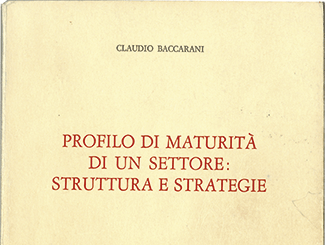 29
Ottobre
2014
29
Ottobre
2014
1985, the odyssey of ceramics: how we came out of that crisis
The Association’s 50th anniversary provides a good opportunity to analyse, through the reading ot essays and works, the reasons of success of the Italian ceramic tile industry, its peculiarities and ability to face the crisis. This is the introduction of Claudio Baccarani’s “Maturity profile of a sector: structure and strategies”, Edizioni CEDAM (1985), available with the publisher and the author’s permission.
Ceramic tile industry is undergoing a crisis which started around 1980: many companies and production units are closing down, employment rate is falling, and cash flows are limited.
Yet this does not apply to everyone: there are growing organizations with a good return on invested capital which have been able to profit from every “crisis-generated opportunity”.
Having said that, the tile sector is generally trying to find a new state of balance to step out of the crisis. Two are the reasons of the current situation: a change in demand and the relation between demand and installed production capacity. Considering the tile industry’s life cycle on the basis of the evolution of demand, one can notice that the sector is currently going through a “mature” stage, almost towards saturation.
In this context lies the relation between demand and installed production capacity. There is an excessive production capacity – approximately 90-100 million sqm per year, corresponding to about 25% of available production capacity – exacerbating an already severe competition. The typical markets for the ceramic tile industry are high-income ceramic-oriented areas with a well developped urban structure.
Also tile producers are less competitive than foreign ones, and this is particularly so for Spanish manufacturers whose quality both aesthetically and technically is outstanding, arriving on foreign markets which traditionally bought Italian products.
Yet it is unlikely that the expected increased demand will be able to absorb the current excess of production capacity. There has always been a type of competition based on process technology innovation which tends to generate an increase in production capacity despite companies closing down.
The current unbalance between production capacity and demand could go on for a while regardless of changes arising from market behaviours. Which means that in the medium term the balance between demand and offer will be reached thanks to the closing down of more companies. This reduced capacity will most probably concern those companies combining little efficiency (that is little productivity and cost-effectiveness) with an inefficient market strategy lacking labour segmentation and product differentiation.
This physiological adjustment may not happen, depending on two conditions: the companies enjoy such great margins that they are able to face considerable price cuts; the introduction of “forced survival” Welfare State mechanisms. Hopefully the latter won’t become reality: companies with technically and economically poor structures should be prevented from possibly distorting competition to the point that healthy firms have to close down because of their financial unbalance.
As far as strategies are concerned the once stable market induced companies to choose a production-oriented policy, thus generating efficient and effective organisational structures and general stability.
But the current crisis and instability underline the lack of effective organization companies are experiencing right now. If by saying effective organization we mean the companies’ capacity to adapt to external changes we can see how elementary they are in their organization.
These companies are highly specialized structures with defined and separated roles, highly mechanicized and suitable for operating in stable conditions. They mostly lack the capacity to monitor changes, so there is a flattening in recognizing the sector changing variables.
This flattening trend concerns most of the sector because of the similarity of the companies’ structures which have more or less the same equipment for analysing the context in which they operate, having been born on imitation. This equipment is so simple that can only work in a short term and is unable to recognize and decode environmental developments; therefore competitiveness is difficult to reach.
In this framework companies with a responsive or stable organization would make decisions regarding production capacity adjustments by taking into account not what would soon happen in the sector but what had just happened.
The excessive production capacity following a slowdown in the market growth rate which was not readily perceived sharpened competition. The adopted strategy, thinking that excessive production capacity had mere economic basis, simply focused on efficiency and on the containment of production cost. One of the consequences of these choices has been the storage of huge quantities of stock outside manufacturing with the beginning of a price war to get rid of it.
Manufacturing tiles does not guarantee that they will be sold. To be sure to sell one must produce what the market and its segments ask for. This is possible if production answers a need and not the other way round. This is the only way to design and produce the best range of products implementing the most suitable market policies.
The survival and development of tile manufacturing firms appears to depend on a manager-oriented restructuring, on the development of a market-oriented business mentality, and on the ability to interact with the environment.
The rebalance of the sector therefore depends on the capacity of companies of undergoing restructuring.
In other words the companies’structures need to be flexible to employ the most suitable strategies, with an enhanced recognition and decoding capacity. This is a fundamental strategy upon which structures are defined and shaped so that they are able of self-generating.
NOTE. Claudio Baccarani (Mirandola, April 10th 1948) graduated in Economics at the University of Padova and has been working as full Professor at the University of Verona since 1990. He has published more than 150 essays.